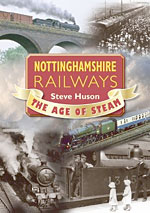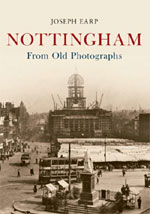Book reviews, Autumn 2014

Nottinghamshire Railways - the Age of Steam by Steve Hudson, Countryside Books 2010
ISBN 978 1 84674 2149
This well-bound A5 publication of 128 pages is a well produced and presented history of the growth of the Nottinghamshire Railways, It has numerous illustrations and photographs and is a very interesting and enjoyable book.
As a steam train enthusiast of long standing, this book has an obvious appeal to the reviewer as it will to like-minded individuals. Even without that enthusiasm the information contained within its well-designed covers is of interest to old and young alike. It demonstrates clearly the reasons why the rail network developed and grew into such a complex system by the middle of the 20th century and gives meaning to the old saying that 'from little acorns, mighty oak trees grow'.
The research undertaken by the author is impressive and is well documented and, given the complexity of the development of the various Companies involved, is written logically and with great attention to detail.
The opening chapters describe in a clear and concise way the County of Nottinghamshire and its characteristics as well as the characters who played a significant part in the coming of the railways to the county. In addition, there is an interesting description of the growth of the coal industry, an important factor in the impetus of the expansion of the railways, not only in Nottinghamshire but it also indicates some of the reasons for the piecemeal growth of the national railway system.
These chapters are followed by detailed descriptions of the growth of the railway system in the County, though 'system' hardly describes the state of the network. These chapters are very well written and identify the considerable infighting battles that took place between rival companies. These battles portray the desire of the rival companies to monopolise the transport of coal from the growing number of mines to the growing number of customers. In addition, they describe the various takeovers and amalgamations of companies that began to give some sort of form to the railway system which was essential for its steady growth.
Quite obviously, the story of the railways cannot ignore the growth of passenger traffic and the effects that this had on the development of the system from the time of Jesse Boot, who introduced the concept of taking his employees for a day out using the railway as the chosen form of transport. Originally they ventured no further than the River Trent near Bleasby, but then went on to use Skegness as their favourite destination. Other companies followed suit, namely Home Breweries and Daybrook Laundry. The Mining industry, however, was reluctant to follow these examples and it was left to the growing number of Miners' Welfare clubs to introduce these treats for their members.
The final chapters bring the story more or less up-to-date and contain details of more modern expansion due to the opening of more modern mines, only for the network to be decimated by the notorious Dr. Beeching in the 1960s.
Thankfully the book ends on a more optimistic note in describing some of the valuable work being carried out by volunteers in the preservation and re-introduction of some of the more attractive lines for the use of people in their leisure time.
I have no hesitation in recommending this book, not only for rail enthusiasts, but also for those who value more social history information.
Alan Butler

Nottingham from Old Photographs by Joseph Earp, Amberley
ISBN 978-1-4456-3459-3 £12.99
The latest title in Amberley Publishing's From Old Photographs series, this is a collection of photographs and some other images telling the story of Nottingham as seen over the last couple of centuries.
Several of the images chart the destruction of much of historic Nottingham, with the demise of such treasured remnants as Drury Hill, the Black Boy Hotel and, more recently, Garner's Hill, all being depicted.
Most of the photographs come from the collection of the late Paul Nix of Nottingham Hidden History, collected over a period of forty years and, therefore, there are some newly published images.
Joseph Earp is now the Team Leader of the Nottingham Hidden History Team. He also writes on history topics for various local publications.
If photographs of our city's past are for you, this is another book worth considering.
Barbara Cast

Ideas and Images in Twelfth Century Sculpture Mary Curtis Webb; re-edited by Gillian Greenwood CD 2012 from http// :buck.ugent.be/fulltxt/ RUG01/001/879/684/RUG01-001879684_2012_0001_AC.pdf
This volume, now available on CD but also through the above link, is a work of real dedication. Mary Curtis Webb undertook to visit and study hundreds of churches over a period of many years, mainly in England but some in other countries. Her purpose was to view carvings of the 12th century, a period which saw the end of a particular kind of imagery in which she became an expert.
The focus of the work is in identifying common themes in images found in the 12th century carvings and art. The many carvings for her study were found by Mary Webb around doorways, on tympana and fonts.
She also spent a great deal of time in the British Library and other depositories, considering similar pictorial images in 12th century manuscripts.
Included in the study are some East Midland examples, the Southwell and Hoveringham tympana amongst them, both examples of the winged Christ. Another local example is from Ault Hucknall, just in Derbyshire, where Christ fighting the Leviathan is depicted on a small tympanum sited over a blocked up door.
You could say that Mary's was almost a life-long task - she never finished finding new examples. As a result the book was not completed by her and it remained for her daughter, Gillian Greenwood, to sort through all her papers and edit it so that this fascinating study of the common themes in 12th century church carvings and art can be widely appreciated.
Barbara Cast